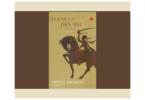Two women who shaped the greatest epic of all times – Mahabharata; one whose womb became a medium to fulfill a higher purpose of Gods and men, the other who guided events to suit her desires and ambitions. “Winds of Hastinapur” is a part mythology, part fiction novel, told through the eyes of these two women – Ganga and Satyavati.
The story begins before the birth of the narrator of the Mahabharata – Ved Vyasa. Ganga is a young maiden training to be the next Lady of the River. Cursed by Arundhati, the eight Vasus are doomed to be born on earth, with the eighth and youngest Vasu – Prabhasa, doomed to live the longest. Ganga is chosen to be their mother, and they are born in the royal household of Hastina, to be thrown into the river and released of the curse. The last Vasu, reborn as Devavrata (later known as Bhishma), spends his learning years on Meru, the home of the Celestials, and learns of its mysteries. On learning of the true reason for the long lives of the Celestials, he is disenchanted and, spurning all attempts by Ganga to keep him on Meru, descends back to earth, to claim his place as the son of King Shantanu.
The second part of the narration is through the voice of Satyavati and begins at the point where Devavrata has descended to earth to take his place as the Prince of Hastina. The story traces her life – as Kali or Matsyagandha (one who smells like a fish), the teenage fisher-woman on the banks of Ganga, to her ascent as Satyavati, Queen of Hastinapur. Events up to the birth of Dhritarashtra and Pandu – her fascination with the sage Parashara, her evolution into Yojanagandha (one whose fragrance spreads miles), seduction of Shantanu, Bhishma’s oath, birth and death of her own sons Chitrangada and Vichitravirya, re-discovery of her son Ved Vyasa – are woven effortlessly into the narration.
The book depicts two diametrically opposite personalities of the female entity. Ganga is the powerful, yet helpless maiden, who oscillates between her love for her only remaining child and her duties as the Lady of the River. Komarraju excellently portrays her anguish on having to kill seven of her children, having to part with the eighth one, being unable to mother a girl who can be her heir, and her knowledge that none of these happenings are of her own choosing. The events in her life are, directly or indirectly, dictated by the people and events around her – Arundhati’s curse, her mother, Shantanu’s curiosity and finally her son’s Devavrata’s disillusionment with Meru.
Satyavati, on the other hand, braids her life into the pattern she wishes. She is unafraid to father a son out of wedlock with the sage Parashara, seduces the King of Hastina to become the Queen, goads Bhishma into making the oath that is to change the course of history, and is willing to let her illegitimate son father children from her daughters-in-law, just so Hastina can have a successor. She actively participates in the courtroom politics, taking her place as Queen in true meaning. She sees her follies and willingly accepts responsibility for them.
While countless renditions of the Mahabharata have been written, most of the popular ones focus on the Pandavas, Kauravas, and the Great War. ‘Winds of Hastinapur’ provides a different and interesting perspective of the epic, concentrating on the stories that lead up to the actual story. A must read for anyone who enjoys historical fiction.
Be a good Samaritan: If you liked this review, please share it with others. If you did not, share it with us in the comments below 🙂
We regularly publish original book reviews which you can be read here. Contact us if you are an author/publisher and want us to review your work.
Our affiliates:
If you would like to purchase ‘The Winds of Hastinapur’ by Sharath Komarraju, you can do so from our affiliates at
Flipkart: The Winds of Hastinapur
Amazon (Kindle ed.): Winds of Hastinapur
Amazon (Paperback): The Winds of Hastinapur
Tell-A-Tale gets a small share of the purchases you make from the affiliate link, helping us bring you the stories you love to read





I have always loved mythological stories. This one sounds intriguing as Ganga and Satyavati’s point of view may shed light on many different aspects of the story.